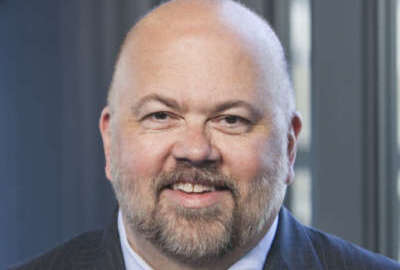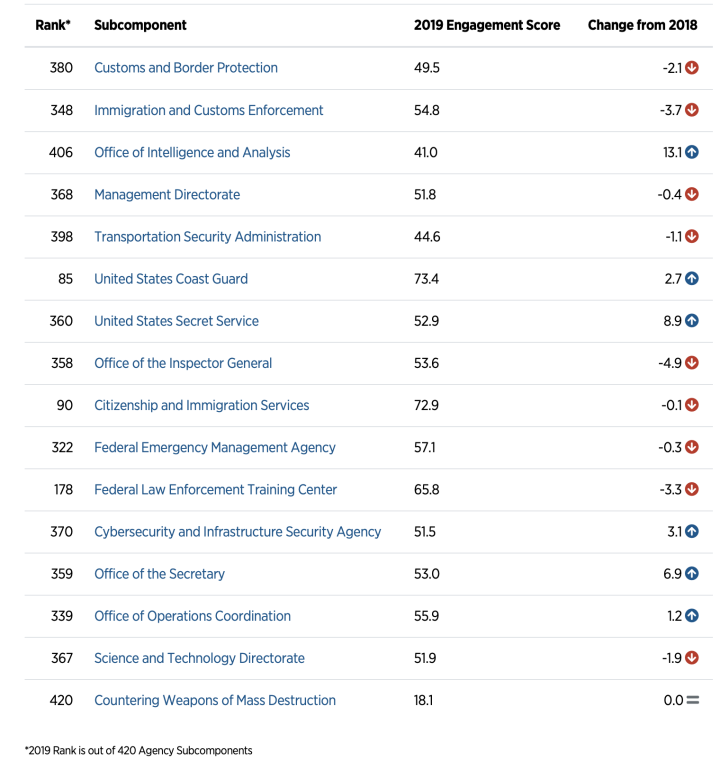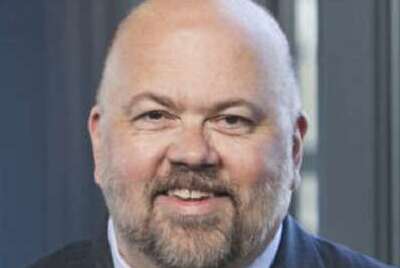
Layers of problems drive morale issues at DHS
DHS morale numbers are unlikely to rise without significant reforms on multiple levels.
This column was originally published on Jeff Neal’s blog, ChiefHRO.com, and was republished here with permission from the author.
The Oversight, Management and Accountability Subcommittee of the House Committee on Homeland Security held a hearing on Jan. 14 to discuss morale at the the Department of Homeland Security. The hearing was prompted by DHS once again ranking at the bottom of the Partnership for Public Service Best Places to Work in the Federal Government rankings.
DHS Chief Human Capital Officer Angela Bailey testified that DHS had significantly improved its numbers, citing the Secret Service and its systematic approach to dealing with morale issues, and the Transportation Security Administration’s steady improvement in morale. She described DHS’ approach, with focus on areas that employees have identified as critical drivers of morale.
Chris Currie, director of the Government Accountability Office Homeland Security and Justice Team, testified that current and former DHS leadership clearly care about the issue of morale. He said DHS is making slow and steady progress, in part by following some of the recommendations GAO has made. He said that while DHS has a unique mission, other departments and agencies have unique missions and are able to maintain high levels of employee morale. He cited the Coast Guard as a component of DHS that has far better morale and a long history of strong leadership. He suggested the Committee also talk with DHS leaders and that they put the same level of attention on mission support as on mission issues.
Max Stier, president of the Partnership for Public Service, testified that DHS has an excellent Chief Human Capital Officer in Bailey. He highlighted the improvements in some components, specifically:
- The Office of Intelligence and Analysis saw a 13.1-point increase in 2019 and the Office of the Secretary jumped 6.9 points.
- U.S. Citizenship and Immigration Services, which ranks 90th of 420 subcomponents, has an index score of 72.9/100 and has improved 14 points from its 2005 low.
- USCG improved its score, rising 2.7 points. Of all 420 subcomponents across government included in the rankings, the Coast Guard remains the highest-ranked DHS subcomponent – 85th of 420 subcomponents.
- The Secret Service is worth highlighting for its 8.9-point jump in 2019 for an index score of 52.9/100, a 61% improvement from its 2016 low score of 32.8.
- The Cybersecurity and Infrastructure Security Agency has improved in five of the last six years, from 36.2 in 2013 to 51.5 in 2019.
Stier also identified specific steps DHS could take to improve morale:
- Congress should hold hearings regularly to focus on DHS morale issues.
- Hold leaders accountable — political appointees should have performance plans.
- Provide continuity in senior management ranks (five under secretaries for Management in five years), as DHS has too many political appointees.
- Provide budget stability — shutdowns are burning down your own house.
- Consolidate congressional jurisdiction over DHS.
- Modernize the Federal Employee Viewpoint Survey.
- Continue to improve data and metrics.
- Ensure that political leaders are focused on engagement and management.
- Enhance career leadership development.
- Create a culture of continual learning, reskilling and upskilling.
- Work to fill vacancies.
Three issues that the witnesses highlighted stand out. First is the improvement in morale in several components. The improvements they have made are real, and they can make a difference for those components. The problem with DHS-wide numbers is that they are driven by the largest components, i.e. TSA and CBP, which comprise 60% of the DHS workforce. Here are all of the component Best Places rankings:

DHS morale numbers are unlikely to rise beyond last place in the Best Places rankings if significant morale improvements are not made in TSA and CBP. Between 2018 and 2019, CBP’s overall rating dropped 2.1 points, while TSA dropped 1.1 points. Their number of employees is so large that it is very difficult for DHS to have an overall improvement. What that highlights is that looking at the department as a whole is a futile exercise. Improvements in morale are not made at the department level. They come at the component level and below.
DHS is not unique in that respect. Highlighting the overall DHS number accomplishes nothing, and may interfere with the ability of the department’s components to make the improvements they need.
Morale is driven by many factors, but the most consequential are the work itself and the quality of leaders. DHS and its components, like most other agencies, like to point to the employee responses on their dedication to the mission. The problem with that number is that virtually every agency has high numbers. When I say the work itself is a driver, I mean the nature of the work and the conditions under which it is performed. If we use TSA as an example, transportation security officers are clearly dedicated to the mission. The problem is that they carry out that mission with low pay, high stress, and with an unrelenting workload.
Related Stories
The final issue that resonated with me is the effect of political employees on morale and the ability of organizations to make sustained improvements. Stier highlighted the issue and suggested DHS should have far fewer political appointees. I have been both a career employee and a political appointee, and I believe he is correct. Turnover in political appointees generates a lack of continuity and makes solutions to longstanding problems difficult, if not impossible. The Office of the Chief Human Capital Officer at DHS is a great example. I was a political appointee in that position, and served as the fifth permanent DHS CHCO. There had also been multiple acting CHCOs. When I started the job, DHS had existed for six years. How could anyone expect to see improvement in human capital matters when the CHCOs left every few months?
I recommended to then-Secretary Janet Napolitano that she convert the position to a career job after I left. Since then (eight years ago), DHS has had two CHCOs and Bailey, the second, is still there. The issue of political appointees has been made even worse by the current administration’s apparent lack of interest in making permanent appointments to senior political jobs. Here is a look at some of the key senior DHS jobs that are filled by acting officials:
- Secretary (acting) Chad F. Wolf
- Deputy Secretary (vacant), Ken Cuccinelli, senior official performing the duties of the deputy secretary
- Chief of Staff (acting), Chad Mizelle
- Executive Secretary (acting), Juliana Blackwell
- General Counsel (acting), Joseph B. Maher
- Under Secretary, Management (vacant), Randolph D. “Tex” Alles, senior official performing the duties of the under secretary for management
- Chief Financial Officer (acting), Stacy Marcott
- Chief Information Officer (acting), Elizabeth A. Cappello
- Under Secretary, Science and Technology (vacant), William (Bill) Bryan, senior official performing the duties of the under secretary for Science and Technology
- Deputy Under Secretary (acting), Andre Hentz
- Director, U.S. Citizenship and Immigration Services (vacant), Ken Cuccinelli, senior official performing the duties of the director, U.S. Citizenship and Immigration Services
- Commissioner, U.S. Customs and Border Protection (acting), Mark A. Morgan
- Administrator, Federal Emergency Management Agency (acting), Pete T. Gaynor
- Director, U.S. Immigration and Customs Enforcement (vacant), Matthew T. Albence, senior official performing the duties of the director, U.S. Immigration and Customs Enforcement
- Assistant Secretary, Countering Weapons of Mass Destruction Office (acting), Gary Rasicot
Having acting officials in 15 of the most critical DHS positions makes any kind of sustained improvement far more challenging. The only positions on this list that really need to be political appointees are the secretary and deputy secretary, but making that change would require Congress and the president to agree to change the law, and that is not likely to happen.
At a minimum, the positions should have fixed terms, such as the five-year term for the administrator of the Transportation Security Administration. If all of the senior DHS political jobs, other than the secretary and deputy secretary, had fixed five-year terms and could be removed only for cause, we might see all of the components better positioned to make real change.
Jeff Neal authors the blog ChiefHRO.com and was previously the chief human capital officer at the Department of Homeland Security and the chief human resources officer at the Defense Logistics Agency.
Copyright © 2025 Federal News Network. All rights reserved. This website is not intended for users located within the European Economic Area.




